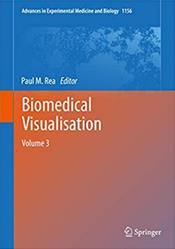|
|
|
|
|

|
| Available: Yes* |
| This title does not qualify for any discount. |
|
Other formats:
|
| Edition: | 1st |
| Publisher: | Springer Nature |
| ISBN: | 3-030-19385-3 (3030193853) |
| ISBN-13: | 978-3-030-19385-0 (9783030193850) |
| Binding: | E E Book + ProQuest Ebook Central |
| Copyright: | 2019 |
| Publish Date: | 09/19 |
| Volume: | 1156 |
| Weight: | 0.00 Lbs. |
| Subject Class: | HEM (Hematology) |
| Return Policy: | Non-Returnable. |
| |
|
| ProQuest Ebook Central�: |
 Please sign in to preview this title
Please sign in to preview this title
|
|
|
| |
| ISSN Series: | Advances in Experimental Medicine & Biology | | Discipline: | Radiology | | Subject Definition: | Imaging, Three-Dimensional | | NLM Class: | WN 180 | | LC Class: | R857 | | Abstract: | This edited book explores the use of technology to enable us to visualise the life sciences in a more meaningful and engaging way. It will enable those interested in visualisation techniques to gain a better understanding of the applications that can be used in visualisation, imaging and analysis, education, engagement and training.The reader will be able to explore the utilisation of technologies from a number of fields to enable an engaging and meaningful visual representation of the biomedical sciences, with a focus in this volume related to anatomy, and clinically applied scenarios.The first six chapters have an anatomical focus and examine a wide range of digital technologies and how they can be used, applied and adapted to enhance anatomical education. The first of these chapters examines the history and development of ultrasound, and the applications in an educational setting, and also as a point-of-care ultrasound (POCUS) at the bedside for more rapid diagnosis of clinical conditions as they present. The second chapter presents an innovative way to combine several software packages to create a fully interactive educational and training package to enhance understanding of an area which can be challenging to learn about from a macro to micro level that of the circadian rhythm. This chapter presents a transferable workflow methodology, which could be used in many fields where the aim is to develop interactive training packages. The third chapter is a review of tools and technologies, which can be used to enhance off-campus learning, and up to the current range of visualisation technologies like virtual, augmented and mixed reality systems. Chapter four discusses how using scanning methodologies like CT imagery can make stereoscopic models. It will highlight case examples of how to develop anatomical visualisation using stereopsis. The fifth chapter describes a novel way to reconstruct 3D anatomy from imaging datasets and how to build statistical 3D shape models, or SSMs. This will also be examined in a clinical context and will examine how this can lay the foundation for advanced diagnostic disease scoring. The sixth chapter examines how to apply interactive visualisations of atlas information in the creation of a virtual resource, and the recent advances for providing next generation interfaces.The seventh and eight chapters discuss clinically relevant applications, with the seventh chapter using serious games in neurofeedback for mental health |
|
|
* Subject to ProQuest Ebook Central� availability |
|
|
|
|
|
Follow Matthews Book Co. on:

Copyright © 2001-2024 Matthews Book Company - All rights reserved. - 11559 Rock Island Ct., Maryland Heights, MO, 63043 - (800) MED-BOOK
Matthews